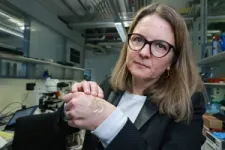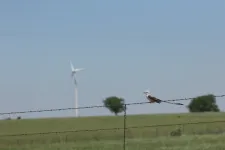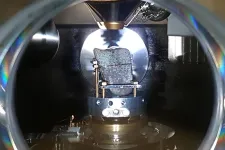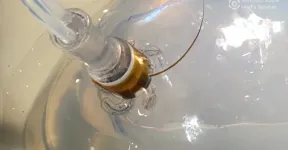(Press-News.org) The Science
Neutrinos are subatomic particles that interact with matter extremely weakly. They are produced in many types of radioactive decays, including in the core of the Sun and in nuclear reactors. Neutrinos are also impossible to block—they easily travel from the core of a nuclear reactor to a detector far away, and even through the Earth itself. Detecting the tiny signals from neutrinos therefore requires huge devices that are extremely sensitive. The SNO+ experiment has just shown that a detector filled with simple water can still detect reactor neutrinos, even though the neutrinos create only tiny signals in the detector.
The Impact
The SNO+ measurement shows that distant nuclear reactors can be observed and monitored with something as simple and inexpensive as water. Reactors cannot shield the neutrinos they produce. This means SNO+’s measurement is a proof of the idea that such water detectors could play a role in ensuring nuclear non-proliferation. Like SNO+, such detectors would still need to be very clean of any radioactivity, large (SNO+ contains 1,000 tons of water), and able to detect the tiny amount of light that the neutrinos produce. The use of water, however, means that very large detectors are possible and a real option for “seeing” even very distant reactors.
Summary
Scientists long thought that the tiny signals (just 10-20 photons) created by reactor neutrinos in a water detector would make it impossible to detect those neutrinos, particularly when the detector was far away from the reactor and the rate of these signals was very low. By ensuring that the detector was clean from even trace amounts of radioactivity, and by having an energy threshold lower than any water detector ever built, SNO+ was able to see these signals and show that they came from nuclear reactors at least 240 kilometers (150 miles) away. The measurement was still quite difficult, as backgrounds (fake events) from residual radioactivity, and from neutrinos created in the atmosphere by cosmic rays, needed to be identified and removed.
Water detectors have several advantages. They are inexpensive and can be very large, making them useful for monitoring reactors across international borders. Improvements to such monitoring, including using water-based liquid scintillator or “loading” the water with gadolinium, both of which would boost the signal size, are being tested by other collaborations. This work is from the SNO+ Collaboration, an international collaboration of roughly 100 scientists from the United States (the University of Pennsylvania, the University of California at Berkeley and Lawrence Berkeley National Laboratory, the University of California at Davis, Brookhaven National Laboratory, Boston University, and the University of Chicago), Canada, the United Kingdom, Portugal, Germany, China, and Mexico. SNO+ is located in SNOLAB, the Canadian underground laboratory.
Funding
SNO+ is funded by the Department of Energy Office of Science, Office of Nuclear Physics and has received funding from the National Science Foundation and the Department of Energy National Nuclear Security Administration through the Nuclear Science and Security program. Funding in Canada comes from Canada Foundation for Innovation, Natural Sciences and Engineering Research Council, Canada Institute for Advanced Research, Queens University, the Ontario Ministry of Research, Innovation and Science, the Alberta Science and Research Investments Program, the Federal Economic Development Initiative for Northern Ontario, and the Ontario Early Researcher Awards. In the United Kingdom, funding has come from the Science and Technology Facilities Council, the European Union’s Seventh Framework Programme under the European Research Council grant agreement, and the Marie Curie grant agreement. Funding has also come from the Fundaçáo para a Ciência e a Tecnologia (FCT-Portugal), the Deutsche Forschungsgemeinschaf in Germany, DGAPA-UNAM and Consejo Nacional de Ciencia y Tecnología in Mexico, and Discipline Construction Fund of Shandong University in China.
END
Detecting neutrinos from nuclear reactors with water
The SNO+ experiment has for the first time shown that neutrinos from a nuclear reactor over 240 km away can be detected with plain water
2023-05-10
ELSE PRESS RELEASES FROM THIS DATE:
When A.I. discloses personal information, users may empathize more
2023-05-10
In a new study, participants showed more empathy for an online anthropomorphic artificial intelligence (A.I.) agent when it seemed to disclose personal information about itself while chatting with participants. Takahiro Tsumura of The Graduate University for Advanced Studies, SOKENDAI in Tokyo, Japan, and Seiji Yamada of the National Institute of Informatics, also in Tokyo, present these findings in the open-access journal PLOS ONE on May 10, 2023.
The use of A.I. in daily life is increasing, raising interest in factors that might contribute to the level of trust and acceptance people feel towards A.I. agents. Prior research has suggested that people are ...
Bird and bat deaths at wind turbines increase during species’ seasonal migrations
2023-05-10
Bird and bat fatalities at wind turbines increase during seasonal migrations – information which could aid their protection, according to a study published May 10, 2023 in the open-access journal PLOS ONE by John D. Lloyd from the Renewable Energy Wildlife Institute of Washington DC, USA, and colleagues.
While there have been local and regional studies on bird and bat deaths caused by wind turbines, this study looks at data from 248 wind turbine facilities across the United States—almost 30 percent ...
Copper artefacts reveal changing connections in prehistoric Europe
2023-05-10
The geochemistry of copper artefacts reveals changes in distribution networks across prehistoric Europe, according to a study published May 10, 2023 in the open-access journal PLOS ONE by Jan Piet Brozio of Kiel University, Germany and colleagues.
Early copper artefacts are considered to have a high cultural and historical significance in European prehistory, but limited information exists about how copper was used and distributed in Neolithic Europe. In this study, the authors analyzed 45 copper objects, including axes, chisels, and other items, from various sites dating to the 4th and 3rd millennia BC of Northern Central Europe and Southern ...
Pregnant and lactating dogs share patterns of some blood metabolites - including glucose and fatty acid concentrations - with pregnant women, according to study of 27 dogs representing 21 breeds
2023-05-10
Article URL: https://journals.plos.org/plosone/article?id=10.1371/journal.pone.0284570
Article Title: Metabolomics during canine pregnancy and lactation
Author Countries: Switzerland, Germany, Finland
Funding: The costs were covered by the Freie Universitaet Berlin (examination, sampling) without any specific funding and PetBiomics Ltd provided material support (Analyses). PetBiomics Ltd employee Claudia Ottka and PetBiomics Ltd chairman Hannes Lohi were involved in the analysis and the preparation of the manuscript. The funders had no role in study design, data collection and decision to publish. END ...
Australian bushfires likely contributed to multiyear La Niña
2023-05-10
The catastrophic Australian bushfires in 2019-2020 contributed to ocean cooling thousands of miles away, ultimately nudging the Tropical Pacific into a rare multi-year La Niña event that dissipated only recently.
The research was led by the National Center for Atmospheric Research (NCAR) and in Science Advances.
La Niña events tend to impact the winter climate over North America, causing drier and warmer than average conditions in the southwest U.S., wetter weather in the Pacific Northwest, and colder temperatures in Canada and the northern U.S. Because the emergence of La Niña can ...
Deployable electrodes for minimally invasive craniosurgery
2023-05-10
Stephanie Lacour’s specialty is the development of flexible electrodes that adapt to a moving body, providing more reliable connections with the nervous system. Her work is inherently interdisciplinary.
So when a neurosurgeon asked Lacour and her team to come up with minimally invasive electrodes for inserting through a human skull, they came up with an elegant solution that takes full advantage of their expertise in compliant electrodes, and inspired by soft robotics actuation. The results are published in Science Robotics.
The challenge? To insert a large cortical electrode array through a small hole in the skull, deploying the device in a space that measures about ...
Study: AI models fail to reproduce human judgements about rule violations
2023-05-10
In an effort to improve fairness or reduce backlogs, machine-learning models are sometimes designed to mimic human decision making, such as deciding whether social media posts violate toxic content policies.
But researchers from MIT and elsewhere have found that these models often do not replicate human decisions about rule violations. If models are not trained with the right data, they are likely to make different, often harsher judgements than humans would.
In this case, the “right” data are those that have been labeled by humans who were explicitly asked whether items defy a certain rule. Training involves showing a machine-learning ...
Built to outlast: Body type may give athletes upper hand in certain climates
2023-05-10
Triathlons such as Ironman and Norway's Norseman competition epitomize human endurance with competitors undertaking nearly 150 miles of running, swimming and biking in grueling conditions.
But behind the training and resilience may be basic rules of ecology that help determine the victor long before contestants leave the starting line, according to research from Dartmouth.
An analysis of nearly 200 Ironman contestants over two decades suggests that performance — specifically in the marathon portion of the event — is linked to how an athlete’s physique is adapted to shedding or retaining heat in certain climates.
Published in the journal PLOS ...
Coping Under COVID: Study provides lessons from the pandemic on how to cope with large-scale traumatic events
2023-05-10
A new study in the journal PLOS ONE examines how individuals coped with stressors during the COVID-19 pandemic and which strategies were associated with higher quality of life.
The study’s findings provide important insights for both individuals and institutions as they prepare for and respond to future large-scale traumatic events. It was based on responses from more than 1,000 Americans on their experiences and behaviors during the pandemic.
The research found that problem-focused and emotion-focused coping strategies were associated with higher quality of life, while avoidant coping had a negative correlation.
Problem-focused coping involves ...
MD Anderson research highlights for May 10, 2023
2023-05-10
HOUSTON ― The University of Texas MD Anderson Cancer Center’s Research Highlights showcases the latest breakthroughs in cancer care, research and prevention. These advances are made possible through seamless collaboration between MD Anderson’s world-leading clinicians and scientists, bringing discoveries from the lab to the clinic and back.
Recent developments include a combination therapy for acute lymphoblastic leukemia, new insights into the evolution of anaplastic thyroid cancer, a promising new treatment approach for PTEN/p53-deficient pancreatic cancer, a novel pan-species artificial intelligence model to detect cancer cells, a ...
LAST 30 PRESS RELEASES:
CRISPR primes goldenberry for fruit bowl fame
Mass General Brigham announces new AI company to accelerate clinical trial screening and patient recruitment
Fat tissue around the heart may contribute to greater heart injury after a heart attack
Jeonbuk National University researcher proposes a proposing a two-stage decision-making framework of lithium governance in Latin America
Chromatin accessibility maps reveal how stem cells drive myelodysplastic progression
Cartilaginous cells regulate growth and blood vessel formation in bones
Plant hormone allows lifelong control of proteins in living animal for first time
Swedish freshwater bacteria give new insights into bacterial evolution
Global measures consistently underestimate food insecurity; one in five who suffer from hunger may go uncounted
Hidden patterns of isolation and segregation found in all American cities
FDA drug trials exclude a widening slice of Americans
Sea reptile’s tooth shows that mosasaurs could live in freshwater
Pure bred: New stem cell medium only has canine components
Largest study of its kind highlights benefits – and risks – of plant-based diets in children
Synergistic effects of single-crystal HfB2 nanorods: Simultaneous enhancement of mechanical properties and ablation resistance
Mysterious X-ray variability of the strongly magnetized neutron star NGC 7793 P13
The key to increasing patients’ advance care medical planning may be automatic patient outreach
Palaeontology: Ancient tooth suggests ocean predator could hunt in rivers
Polar bears may be adapting to survive warmer climates, says study
Canadian wildfire smoke worsened pediatric asthma in US Northeast: UVM study
New UBCO research challenges traditional teen suicide prevention models
Diversity language in US medical research agency grants declined 25% since 2024
Concern over growing use of AI chatbots to stave off loneliness
Biomedical authors often call a reference “recent” — even when it is decades old, analysis shows
The Lancet: New single dose oral treatment for gonorrhoea effectively combats drug-resistant infections, trial finds
Proton therapy shows survival benefit in Phase III trial for patients with head and neck cancers
Blood test reveals prognosis after cardiac arrest
UBCO study finds microdosing can temporarily improve mood, creativity
An ECOG-ACRIN imaging study solves a long-standing gap in metastatic breast cancer research and care: accurately measuring treatment response in patients with bone metastases
Cleveland Clinic presents final results of phase 1 clinical trial of preventive breast cancer vaccine study
[Press-News.org] Detecting neutrinos from nuclear reactors with waterThe SNO+ experiment has for the first time shown that neutrinos from a nuclear reactor over 240 km away can be detected with plain water







